Papers by Håvard Mokleiv Nygård
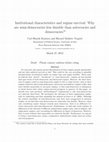
Do autocrats who pursue partial liberalization of their regimes grossly miscalculate and put thei... more Do autocrats who pursue partial liberalization of their regimes grossly miscalculate and put their political survival at risk? This could be the case according to plausible interpretations of statistical studies on regime type and regime stability. These studies indicate that ``mixed'', ``incoherent'' or ``semi-democratic'' regimes are less durable than pure forms of both democratic and dictatorial regimes. However, the short duration of regimes coded as semi-democratic might be due to other factors, such as these regimes relatively often being multi-party autocracies and military regimes rather than more durable monarchies or one-party regimes, or that semi-democracy is endogenous to latent factors that reduce regime-survival prospects in general. In this paper, we identify four such potential ``methodological'' explanations to why semi-democracies are relatively short-lived. We investigate the relevance of these explanations empirically by replicating and then expanding the analysis in \citet{Gates:2006AJPS}. Although the relative instability of semi-democracies may have been exaggerated in previous studies, we do find that semi-democracies are inherently less durable. However, when only considering regime changes towards more democracy, there is no difference between autocracies and semi-democracies. Furthermore, we find only weak evidence of differences in the duration of different authoritarian regime types, such as military and single-party regimes, once accounting for differences in degree of democracy. However, there is some evidence that monarchies are relatively durable. Furthermore, in contrast to being a semi-democracy, being a competitive authoritarian regime does not reduce survival prospects.
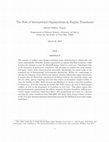
The amount of violence seen during transitions from authoritarian to democratic rule varies subst... more The amount of violence seen during transitions from authoritarian to democratic rule varies substantially. Recently, Tunisia experienced an almost bloodless transition, while in Libya the attempt to oust the Ghadaffi regime ended in a civil war. This paper looks at the dynamics of democratic transitions, and attempts to explain why some become extremely violent while others progress peacefully. Specifically, the paper looks at the potential role of International Governmental Institutions (IGOs) for constraining or altering the behavior of non-democratic regimes, thereby influencing regime transitions. It argues that by alleviating commitment problems between the outgoing regime and the new elites, and by imposing sanctions that reduce an incumbent regime's ability to reap the benefits of office, IGOs increase the likelihood of seeing a peaceful transition to democracy. Previous research has found that IGOs reduce the risk of international conflict, as well as the propensity of escalation in civil wars. This paper argues that intergovernmental organizations also affects situation of regime transition, making non-violent regime transitions much more likely. The propositions are tested on a dataset covering all regime transitions from 1900-2008. The paper finds strong evidence in favor of the view that intergovernmental institutions increase the likelihood of peaceful regime transitions.

Although military cooperation among rebel groups in multi-party civil wars could help rebels defe... more Although military cooperation among rebel groups in multi-party civil wars could help rebels defeat or extract concessions from an incumbent government, violent conflict among rebel groups is empirically prevalent. Why do rebel groups in multi-actor civil wars choose to fight one another? This paper models the strategic dilemma facing rebel groups in multi-party civil wars as an alternating-offer bargaining game of incomplete information with an outside option. The game-theoretic model explores the relationship between the status quo distribution of power among rebel groups, the costs of fighting, and the likelihood that one rebel group will opt to unilaterally end bargaining over a set of goods, such as access to supply routes, natural resources, and control over civilian populations. We show that the likelihood of violent conflict between rebel groups is lowest when the status quo distribution of benefits reflects the existing distribution of power.

Many conflict studies link the sources of social conflicts to sentiments of relative deprivation.... more Many conflict studies link the sources of social conflicts to sentiments of relative deprivation. They typically regard formal democratic institutions as states' most important vehicle to reduce deprivation-motivated armed conflict against their governments. We argue that the wider concept of \emph{good governance} is better suited to analyze deprivation-based conflict. The paper shows that the risk of renewed conflict in countries with good governance drops rapidly after the conflict has ended. In countries characterized by poor governance, this process takes much longer. Hence, improving governance is an important part in reducing the onset and incidence of conflict, and good governance will in turn decrease the likelihood of conflict. We also estimate models that decomposes the effect of good governance into what can be explained by formal democratic institutions and less formal aspects of governance, and into what can be explained by economic development and what is due to how well countries are governed. We find informal aspects of good governance to be at least as important as formal institutions in preventing renewed conflict, and also find that good governance has a clear effect over and beyond economic development.
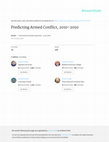
Typescript, University of …, Jun 1, 2013
The article predicts changes in global and regional incidences of armed conflict for the 2010–205... more The article predicts changes in global and regional incidences of armed conflict for the 2010–2050 period. The predictions are based on a dynamic multinomial logit model estimation on a 1970–2009 cross-sectional data set of changes between no armed conflict, minor conflict, and major conflict. Core exogenous predictors are population size, infant mortality rates, demographic composition, education levels, oil dependence, ethnic cleavages, and neighborhood characteristics. Predictions are obtained through simulating the behavior of the conflict variable implied by the estimates from this model. We use projections for the 2011–2050 period for the predictors from the UN World Population Prospects and the International Institute for Applied Systems Analysis. We treat conflicts, recent conflict history, and neighboring conflicts as endogenous variables. Out-of-sample validation of predictions for 2007–2009 (based on estimates for the 1970–2000 period) indicates that the model predicts well, with an area under the receiver operator curve of 0.937. Using a p > .30 threshold for positive prediction, the true positive rate 7–9 years into the future is 0.79 and the False Positive Rate 0.085. We predict a continued decline in the proportion of the world's countries that have internal armed conflict, from about 15% in 2009 to 7% in 2050. The decline is particularly strong in the Western Asia and North Africa region and less clear in Africa south of Sahara. The remaining conflict countries will increasingly be concentrated in East, Central, and Southern Africa and in East and South Asia.
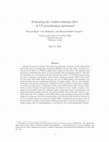
Evaluating the conflict-reducing effect of UN peacekeeping operations, Jan 1, 2011
During the past two decades there has been a dramatic increase in both funds spent and troops sen... more During the past two decades there has been a dramatic increase in both funds spent and troops sent on peacekeeping operations (PKOs). At the same time, systematic research on the efficacy of PKOs to guide policy making is still scarce. We approach this question by simulating the effect of various possible UN peacekeeping policies. We base the simulation on a statistical model that estimates the efficacy of UN PKOs in preventing the onset, escalation, continuation, and recurrence of internal armed conflict in the world for the period 1970--2008. Apart from new data on UN PKO budgets and mandates, the model includes the most important predictors of armed conflict. We use out-of-sample validation of prediction performance to identify the best statistical model and to evaluate its predictive performance. Predictions of how various PKO policies affect future conflict levels are then obtained through simulating the behavior of the conflict variable as implied by the estimates from the statistical model, using projections of demographic and education-related variables from the UN and the IIASA. Our results show that in a scenario where the UN is willing to issue PKOs with strong mandates and increase its PKO budget by 50 percent, the risk of armed conflict in the world in 2035 would be reduced by up to two thirds relative to a scenario without PKOs. Considering the enormous costs of armed conflict, in terms of both human suffering and foregone economic development, our results suggest that UN peacekeeping is a cost-effective way of increasing global security.
World Development, Sep 1, 2012
This paper conducts the first analysis of the effect of armed conflict on progress in meeting the... more This paper conducts the first analysis of the effect of armed conflict on progress in meeting the United Nation’s Millennium Development Goals. We also examine the effect of conflict on economic growth. Conflict has clear detrimental effects on the reduction of poverty and hunger, on primary education, on the reduction of child mortality, and on access to potable water. A medium-sized conflict with 2500 battle deaths is estimated to increase undernourishment an additional 3.3%, reduce life expectancy by about 1 year, increases infant mortality by 10%, and deprives an additional 1.8% of the population from access to potable water.

Annual Meeting of the …, Jan 1, 2010
During the past two decades there has been a dramatic increase in both funds spent and troops sen... more During the past two decades there has been a dramatic increase in both funds spent and troops sent on peacekeeping operations (PKOs). At the same time, systematic research on the efficacy of PKOs to guide policy making is still scarce. We approach this question by simulating the effect of various possible UN peacekeeping policies. We base the simulation on a statistical model that estimates the efficacy of UN PKOs in preventing the onset, escalation, continuation, and recurrence of internal armed conflict in the world for the period 1970-2008. Apart from new data on UN PKO budgets and mandates, the model includes the most important predictors of armed conflict. We use out-of-sample validation of prediction performance to identify the best statistical model and to evaluate its predictive performance. Predictions of how various PKO policies affect future conflict levels are then obtained through simulating the behavior of the conflict variable as implied by the estimates from the statistical model, using projections of demographic and education-related variables from the UN and the IIASA. Our results show that in a scenario where the UN is willing to issue PKOs with strong mandates and increase its PKO budget by 50 percent, the risk of armed conflict in the world in 2035 would be reduced by up to two thirds relative to a scenario without PKOs. Considering the enormous costs of armed conflict, in terms of both human suffering and foregone economic development, our results suggest that UN peacekeeping is a cost-effective way of increasing global security. * The paper has been funded by the Research Council of Norway project 217995/V10. We thank Paul Huth, Burcu Savun, Halvor Mehlum, Nikitas Konstantinidis, ..., and participants at several workshops and conferences for their comments on previous versions of this paper, and Andreas Forø Tollefsen for help with the map.









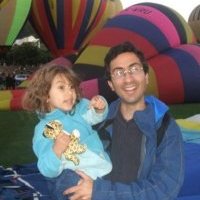
Uploads
Papers by Håvard Mokleiv Nygård